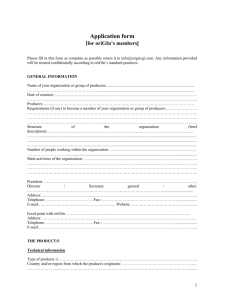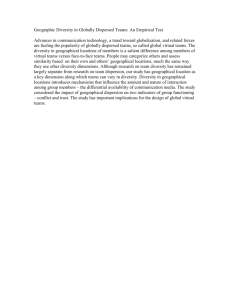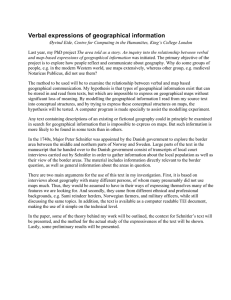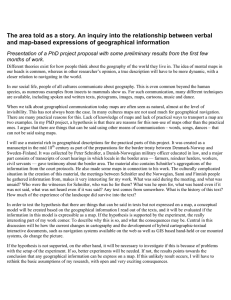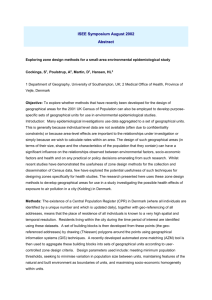Creation of a new industrial property right in and handicraft products"
advertisement
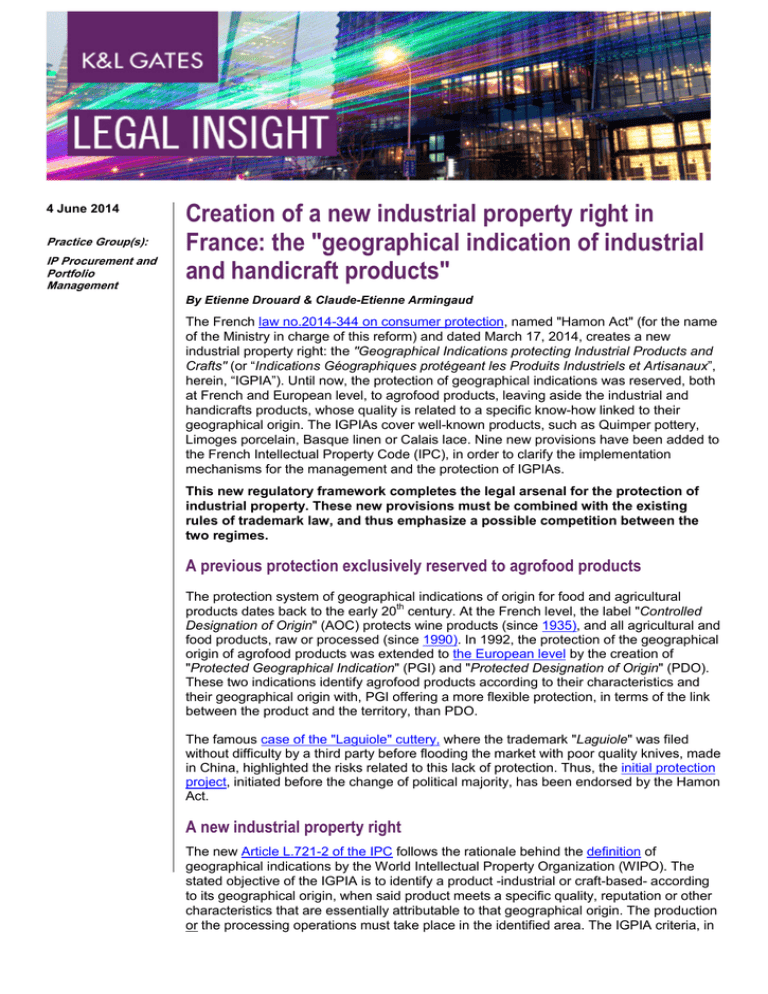
4 June 2014 Practice Group(s): IP Procurement and Portfolio Management Creation of a new industrial property right in France: the "geographical indication of industrial and handicraft products" By Etienne Drouard & Claude-Etienne Armingaud The French law no.2014-344 on consumer protection, named "Hamon Act" (for the name of the Ministry in charge of this reform) and dated March 17, 2014, creates a new industrial property right: the "Geographical Indications protecting Industrial Products and Crafts" (or “Indications Géographiques protégeant les Produits Industriels et Artisanaux”, herein, “IGPIA”). Until now, the protection of geographical indications was reserved, both at French and European level, to agrofood products, leaving aside the industrial and handicrafts products, whose quality is related to a specific know-how linked to their geographical origin. The IGPIAs cover well-known products, such as Quimper pottery, Limoges porcelain, Basque linen or Calais lace. Nine new provisions have been added to the French Intellectual Property Code (IPC), in order to clarify the implementation mechanisms for the management and the protection of IGPIAs. This new regulatory framework completes the legal arsenal for the protection of industrial property. These new provisions must be combined with the existing rules of trademark law, and thus emphasize a possible competition between the two regimes. A previous protection exclusively reserved to agrofood products The protection system of geographical indications of origin for food and agricultural products dates back to the early 20th century. At the French level, the label "Controlled Designation of Origin" (AOC) protects wine products (since 1935), and all agricultural and food products, raw or processed (since 1990). In 1992, the protection of the geographical origin of agrofood products was extended to the European level by the creation of "Protected Geographical Indication" (PGI) and "Protected Designation of Origin" (PDO). These two indications identify agrofood products according to their characteristics and their geographical origin with, PGI offering a more flexible protection, in terms of the link between the product and the territory, than PDO. The famous case of the "Laguiole" cuttery, where the trademark "Laguiole" was filed without difficulty by a third party before flooding the market with poor quality knives, made in China, highlighted the risks related to this lack of protection. Thus, the initial protection project, initiated before the change of political majority, has been endorsed by the Hamon Act. A new industrial property right The new Article L.721-2 of the IPC follows the rationale behind the definition of geographical indications by the World Intellectual Property Organization (WIPO). The stated objective of the IGPIA is to identify a product -industrial or craft-based- according to its geographical origin, when said product meets a specific quality, reputation or other characteristics that are essentially attributable to that geographical origin. The production or the processing operations must take place in the identified area. The IGPIA criteria, in Creation of a new industrial property right in France: the "geographical indication of industrial and handicraft products" terms of link between the product and the territory, are more flexible than for the AOC and PDO (eg. the raw materials used for the manufacture of products, do not need to come from the geographical area identified). Therefore the IGPIA regime is closer to the European PGI. The application for approval and the monitoring of an IGPIA must be made at the French National Institute for Industrial Property (INPI), by an "Organization for Defense and Management", bearing legal personality (art. L.721-4 of the IPC), according to specifications, which must indicate precisely the relationship between the product and its geographical indication. The IGPIA enjoy a broad protection that guarantees the products against any practice likely to mislead the consumer with regards to its true origin and its qualities. Any breach of protection given to a product by an IGPIA may be punished by a sentence up to two years imprisonment and up to € 300.000 fine. Competition with the trademarks law? The IGPIA system must be analyzed in connection with legal provisions already applicable to trademarks protection, thus likely creating competition between beneficiaries of the two regimes. According to Article L.712-4 of the IPC, as amended by the Hamon Act, the right of opposition may now be exercised by a local authority or an Organization for Defense and Management of an IGPIA. Similarly, the Hamon Act amends Article L.711-4 of the IPC, the IGPIA being added to the list of prior rights which may justify the reject of an application for filling or the cancellation of a registered trademark. Thus, a trademark may be canceled pursuant to Article L.714-3 of the IPC, if it affects the prior rights related not only to a "geographical indication", but also to "the name, the image or the reputation of a territorial authority". Finally, Article L.712-2-1 of the IPC creates a warning system for territorial authorities, which can now request from the INPI to be informed in the event of the application for a trademark containing their name. The Hamon Act, with the creation of IPGIA, offers to the industrialists and the artisans a new legal tool in order to defend their know-how, and to the territorial authorities to protect their local economy. For now, the effective protection of IPGIA stops at national borders. Nevertheless, the European Union is seriously considering the possibility to extend the IGP to non-agrofood products. Consequently, a true evolution of the protection system of industrial property has been initiated. Indeed, the owner of a trademark containing a geographical indication, when its production does not bear a sufficient connection with a local know-how, could see its trademark canceled, if a local authority proves that it infringes on its name, image or reputation, or if the owner of an IGPIA claims a first-in-time priority. Trademarks holders will now have to take into account the interests and prerogatives of local authorities and local actors, wishing to protect their handcraft and reputation. Authors: Etienne Drouard etienne.drouard@klgates.com +33 (0)1.58.44.15.12 Claude-Etienne Armingaud claude.armingaud@klgates.com +33 (0)1.58.44.15.16 2 Creation of a new industrial property right in France: the "geographical indication of industrial and handicraft products" Anchorage Austin Beijing Berlin Boston Brisbane Brussels Charleston Charlotte Chicago Dallas Doha Dubai Fort Worth Frankfurt Harrisburg Hong Kong Houston London Los Angeles Melbourne Miami Milan Moscow Newark New York Orange County Palo Alto Paris Perth Pittsburgh Portland Raleigh Research Triangle Park San Diego San Francisco São Paulo Seattle Seoul Shanghai Singapore Spokane Sydney Taipei Tokyo Warsaw Washington, D.C. Wilmington K&L Gates comprises more than 2,000 lawyers globally who practice in fully integrated offices located on five continents. The firm represents leading multinational corporations, growth and middle-market companies, capital markets participants and entrepreneurs in every major industry group as well as public sector entities, educational institutions, philanthropic organizations and individuals. For more information about K&L Gates or its locations, practices and registrations, visit www.klgates.com. This publication is for informational purposes and does not contain or convey legal advice. The information herein should not be used or relied upon in regard to any particular facts or circumstances without first consulting a lawyer. © 2014 K&L Gates LLP. All Rights Reserved. 3
